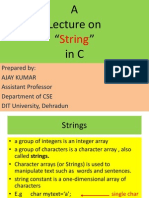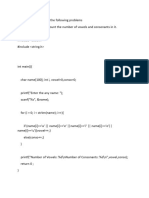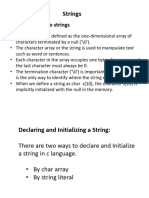0% found this document useful (0 votes)
20 views16 pagesString
The document provides an overview of the basic concepts of C programming, focusing on ASCII values and strings. It explains how ASCII assigns numerical values to characters, illustrates string initialization and manipulation, and discusses various string functions from the C standard library. Additionally, it includes practice problems to reinforce understanding of string handling and character operations.
Uploaded by
Agniva MukherjeeCopyright
© © All Rights Reserved
We take content rights seriously. If you suspect this is your content, claim it here.
Available Formats
Download as PDF, TXT or read online on Scribd
0% found this document useful (0 votes)
20 views16 pagesString
The document provides an overview of the basic concepts of C programming, focusing on ASCII values and strings. It explains how ASCII assigns numerical values to characters, illustrates string initialization and manipulation, and discusses various string functions from the C standard library. Additionally, it includes practice problems to reinforce understanding of string handling and character operations.
Uploaded by
Agniva MukherjeeCopyright
© © All Rights Reserved
We take content rights seriously. If you suspect this is your content, claim it here.
Available Formats
Download as PDF, TXT or read online on Scribd
/ 16





















































































